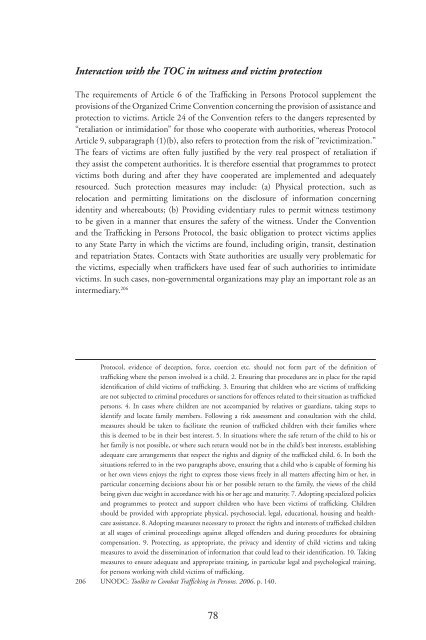Trafficking in human beings: human rights and ... - unesdoc - Unesco
Trafficking in human beings: human rights and ... - unesdoc - Unesco
Trafficking in human beings: human rights and ... - unesdoc - Unesco
Create successful ePaper yourself
Turn your PDF publications into a flip-book with our unique Google optimized e-Paper software.
Interaction with the TOC <strong>in</strong> witness <strong>and</strong> victim protection<br />
The requirements of Article 6 of the Traffi ck<strong>in</strong>g <strong>in</strong> Persons Protocol supplement the<br />
provisions of the Organized Crime Convention concern<strong>in</strong>g the provision of assistance <strong>and</strong><br />
protection to victims. Article 24 of the Convention refers to the dangers represented by<br />
“retaliation or <strong>in</strong>timidation” for those who cooperate with authorities, whereas Protocol<br />
Article 9, subparagraph (1)(b), also refers to protection from the risk of “revictimization.”<br />
The fears of victims are often fully justifi ed by the very real prospect of retaliation if<br />
they assist the competent authorities. It is therefore essential that programmes to protect<br />
victims both dur<strong>in</strong>g <strong>and</strong> after they have cooperated are implemented <strong>and</strong> adequately<br />
resourced. Such protection measures may <strong>in</strong>clude: (a) Physical protection, such as<br />
relocation <strong>and</strong> permitt<strong>in</strong>g limitations on the disclosure of <strong>in</strong>formation concern<strong>in</strong>g<br />
identity <strong>and</strong> whereabouts; (b) Provid<strong>in</strong>g evidentiary rules to permit witness testimony<br />
to be given <strong>in</strong> a manner that ensures the safety of the witness. Under the Convention<br />
<strong>and</strong> the Traffi ck<strong>in</strong>g <strong>in</strong> Persons Protocol, the basic obligation to protect victims applies<br />
to any State Party <strong>in</strong> which the victims are found, <strong>in</strong>clud<strong>in</strong>g orig<strong>in</strong>, transit, dest<strong>in</strong>ation<br />
<strong>and</strong> repatriation States. Contacts with State authorities are usually very problematic for<br />
the victims, especially when traffi ckers have used fear of such authorities to <strong>in</strong>timidate<br />
victims. In such cases, non-governmental organizations may play an important role as an<br />
<strong>in</strong>termediary. 206<br />
Protocol, evidence of deception, force, coercion etc. should not form part of the defi nition of<br />
traffi ck<strong>in</strong>g where the person <strong>in</strong>volved is a child. 2. Ensur<strong>in</strong>g that procedures are <strong>in</strong> place for the rapid<br />
identifi cation of child victims of traffi ck<strong>in</strong>g. 3. Ensur<strong>in</strong>g that children who are victims of traffi ck<strong>in</strong>g<br />
are not subjected to crim<strong>in</strong>al procedures or sanctions for offences related to their situation as traffi cked<br />
persons. 4. In cases where children are not accompanied by relatives or guardians, tak<strong>in</strong>g steps to<br />
identify <strong>and</strong> locate family members. Follow<strong>in</strong>g a risk assessment <strong>and</strong> consultation with the child,<br />
measures should be taken to facilitate the reunion of traffi cked children with their families where<br />
this is deemed to be <strong>in</strong> their best <strong>in</strong>terest. 5. In situations where the safe return of the child to his or<br />
her family is not possible, or where such return would not be <strong>in</strong> the child’s best <strong>in</strong>terests, establish<strong>in</strong>g<br />
adequate care arrangements that respect the <strong>rights</strong> <strong>and</strong> dignity of the traffi cked child. 6. In both the<br />
situations referred to <strong>in</strong> the two paragraphs above, ensur<strong>in</strong>g that a child who is capable of form<strong>in</strong>g his<br />
or her own views enjoys the right to express those views freely <strong>in</strong> all matters affect<strong>in</strong>g him or her, <strong>in</strong><br />
particular concern<strong>in</strong>g decisions about his or her possible return to the family, the views of the child<br />
be<strong>in</strong>g given due weight <strong>in</strong> accordance with his or her age <strong>and</strong> maturity. 7. Adopt<strong>in</strong>g specialized policies<br />
<strong>and</strong> programmes to protect <strong>and</strong> support children who have been victims of traffi ck<strong>in</strong>g. Children<br />
should be provided with appropriate physical, psychosocial, legal, educational, hous<strong>in</strong>g <strong>and</strong> healthcare<br />
assistance. 8. Adopt<strong>in</strong>g measures necessary to protect the <strong>rights</strong> <strong>and</strong> <strong>in</strong>terests of traffi cked children<br />
at all stages of crim<strong>in</strong>al proceed<strong>in</strong>gs aga<strong>in</strong>st alleged offenders <strong>and</strong> dur<strong>in</strong>g procedures for obta<strong>in</strong><strong>in</strong>g<br />
compensation. 9. Protect<strong>in</strong>g, as appropriate, the privacy <strong>and</strong> identity of child victims <strong>and</strong> tak<strong>in</strong>g<br />
measures to avoid the dissem<strong>in</strong>ation of <strong>in</strong>formation that could lead to their identifi cation. 10. Tak<strong>in</strong>g<br />
measures to ensure adequate <strong>and</strong> appropriate tra<strong>in</strong><strong>in</strong>g, <strong>in</strong> particular legal <strong>and</strong> psychological tra<strong>in</strong><strong>in</strong>g,<br />
for persons work<strong>in</strong>g with child victims of traffi ck<strong>in</strong>g.<br />
206 UNODC: Toolkit to Combat Traffi ck<strong>in</strong>g <strong>in</strong> Persons. 2006. p. 140.<br />
78

















